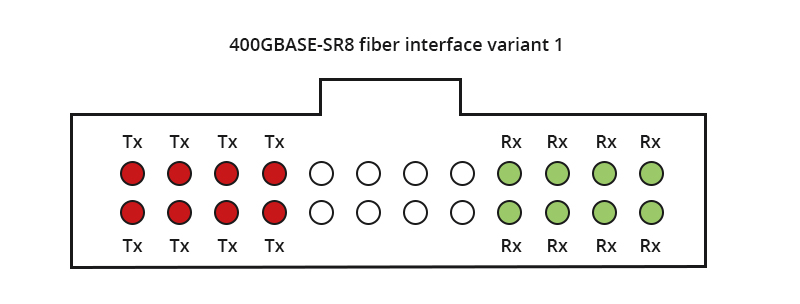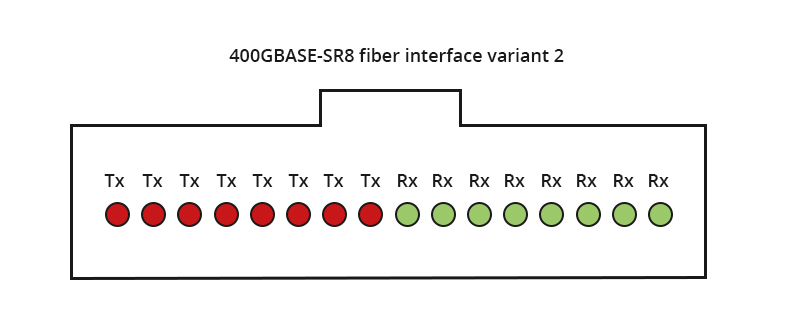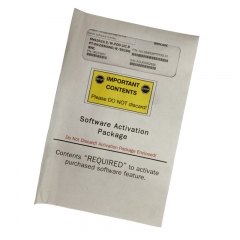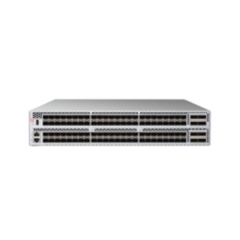400G Multimode Fiber: 400G SR4.2 vs 400G SR8
Cloud and AI applications are driving demand for data rates beyond 100 Gb/s, moving to high-speed and low-power 400 Gb/s interconnects. The optical fiber industry is responding by developing two IEEE 400G Ethernet standards, namely 400GBASE-SR4.2 and 400GBASE-SR8, to support the short-reach application space inside the data center. This article will elaborate on the two standards and their comparison.
400GBASE-SR4.2
400GBASE-SR4.2, also called 400GBASE-BD4.2, is a 4-pair, 2-wavelength multimode solution that supports reaches of 70m (OM3), 100m (OM4), and 150m (OM5). It is not only the first instance of an IEEE 802.3 solution that employs both multiple pairs of fibers and multiple wavelengths, but also the first Ethernet standard to use two short wavelengths to double multimode fiber capacity from 50 Gb/s to 100 Gb/s per fiber.
400GBASE-SR4.2 operates over the same type of cabling used to support 40GBASE-SR4, 100GBASE-SR4 and 200GBASE-SR4. It uses bidirectional transmission on each fiber, with each wavelength traveling in opposite directions. As such, each active position at the transceiver is both a transmitter and a receiver, which means 400GBASE-SR4.2 has eight optical transmitters and eight optical receivers in a bidirectional optical configuration.
The optical lane arrangement is shown as follows. The leftmost four positions labeled TR transmit wavelength λ1 (850nm) and receive wavelength λ2 (910nm). Conversely, the rightmost four positions labeled RT receive wavelength λ1 and transmit wavelength λ2.

400GBASE-SR8
400GBASE-SR8 is an 8-pair, 1-wavelength multimode solution that supports reaches of 70m (OM3), 100m (OM4 & OM5). It is the first IEEE fiber interface to use eight pairs of fibers. Unlike 400GBASE-SR4.2, it operates over a single wavelength (850nm) with each pair supporting 50 Gb/s transmission. In addition, it has two variants of optical lane arrangement. One variant uses the 24-fiber MPO, configured as two rows of 12 fibers, and the other interface variant uses a single-row MPO-16.


400GBASE-SR8 offers flexibility of fiber shuffling with 50G/100G/200G configurations. It also supports breakout at different speeds for various applications such as compute, storage, flash, GPU, and TPU. 400G-SR8 QSFP DD/OSFP transceivers can be used as 400GBASE-SR8, 2x200GBASE-SR4, 4x100GBASE-SR2, 8x50GBASE-SR.
400G SR4.2 vs. 400G SR8
As multimode solutions for 400G Ethernet, 400GBASE-SR4.2 and 400GBASE-SR8 share some features, but they also differ in a number of ways as discussed in the previous section.
The following table shows a clear picture of how they compare to each other.
| 400GBASE-SR4.2 | 400GBASE-SR8 | |
|---|---|---|
| Alliance | IEEE 802.3cm | IEEE 802.3cm (breakout: 802.3cd) |
| Max reach | 150m over OM5 | 100m over OM4/OM5 |
| Fibers | 8 fibers | 16 fibers (ribbon patch cord) |
| Wavelength | 2 wavelengths (850nm and 910nm) | 1 wavelength (850nm) |
| BiDi technology | Support | / |
| Signal modulation format | PAM4 signaling | PAM4 signaling |
| Laser | VCSEL | VCSEL |
| Form factor | QSFP-DD, OSFP | QSFP-DD, OSFP |
400GBASE-SR8 is technically simple but requires a ribbon patch cord with 16 fibers. It is usually built with 8 VCSEL lasers and doesn’t include any gearbox, so the overall cost of modules and fibers remains low. By contrast, 400GBASE-SR4.2 is technically more complex so the overall cost of related fibers or modules is higher, but it can support a longer reach.
In addition, 400GBASE-SR8 offers both flexibility and higher density. It supports fiber shuffling with 50G/100G/200G configurations and fanout at different I/O speeds for various applications. A 400G-SR8 QSFP-DD transceiver can be used as 400GBASE-SR8, 2x200GBASE-SR4, 4x100GBASE-SR2, or 8x50GBASE-SR.
400G SR4.2 & 400G SR8: Boosting Higher Speed Ethernet
As multimode fiber continues to evolve to serve growing demands for speed and capacity, both 400GBASE-SR4.2 and 400GBASE-SR8 help boost 400G Ethernet and scale up multimode fiber links too ensure the viability of optical solutions for various demanding applications.
The two IEEE 802.3cm standards provide a smooth evolution path for Ethernet, boosting cloud-based services and applications. Future advances point toward the ability to support even higher data rates as they are upgraded to the next level. The data center Industry will take advantage of the latest multimode fiber technology such as OM5 fiber, and use multiple wavelengths to transmit 100 Gb/s and 400 Gb/s over fibers over short reach of more than150 meters.
Beyond 2021-2022 timeframe, once an 800 Gb/s Ethernet standard is standardized, using more advanced technology with two-wavelength operation could create an 800 Gb/s, four-pair link. At the same time a single wavelength could support an 800 Gb/s eight-pair link. In this sense, 400GBASE-SR4.2 and 400GBASE-SR8 are setting the pace for a promising future.
 +86 19860146913
+86 19860146913 dsale@topsfp.com
dsale@topsfp.com español
español English
English русский
русский العربية
العربية 中文
中文











